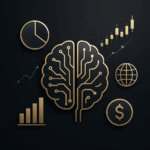The Impact of AI on Long-Term Investment Strategies
Introduction: The Rise of AI in Long-Term Investing
AI long-term investment strategies represent a major turning point for investors seeking sustainable growth and financial stability. The arrival of artificial intelligence in finance has replaced manual analysis with automated, data-driven processes. This evolution affects every stage of portfolio management, from asset evaluation to dynamic risk control.
By 2025, AI has become central to financial planning. Investors must now combine technical understanding with strategic thinking to stay competitive. Those who learn to integrate AI effectively can expect improved accuracy, faster decision-making, and greater adaptability to complex markets.
Understanding AI in Finance: Definitions and Core Technologies
Artificial intelligence in finance uses algorithms, machine learning, and data analytics to replicate aspects of human decision-making. In long-term investing, AI systems process massive volumes of financial and alternative data to detect trends and forecast performance.
Key technologies include supervised and unsupervised learning, deep neural networks, natural language processing (NLP), and reinforcement learning. These tools evaluate market behavior, economic indicators, and sentiment across news and social media. The result is faster, more comprehensive insight than traditional analysis, which often misses subtle, multi-layered relationships between variables.
AI long-term investment strategies therefore enhance diversification, optimize performance evaluation, and help investors navigate uncertainty with precision.
Why AI Matters for Investors in 2025
Financial markets in 2025 have become more dynamic, global, and data-intensive. Traditional models struggle to process the scale of information influencing asset prices. AI provides the necessary intelligence to:
Process Data at Scale: Analyze enormous streams of financial and economic information in seconds.
Identify Hidden Patterns: Detect relationships invisible to human analysts.
Improve Diversification: Optimize asset allocation for stronger, risk-adjusted returns.
Strengthen Risk Control: Automate stress testing and scenario analysis during volatile periods.
AI platforms can analyze sentiment from news, policy changes, and consumer behavior simultaneously. This multi-dimensional approach creates a more complete market picture. Investors benefit from recommendations tailored to their goals, risk profiles, and time horizons—capabilities once limited to large institutions.
Modern AI-Driven Investment Strategies
In 2025, investors employ several AI-driven strategies to improve long-term portfolio outcomes.
Dynamic Portfolio Rebalancing
AI systems forecast market conditions and adjust allocations continuously. Unlike static reviews, this adaptive rebalancing helps maintain target exposures during turbulence or opportunity.
Automated Tax Optimization
Algorithms plan trades to reduce taxable gains and harvest losses strategically. By integrating tax-aware decisions into every transaction, AI maximizes investors’ net returns.
Scenario Analysis and Stress Testing
AI simulations model various economic or geopolitical shocks in real time. These projections prepare investors to handle crises and adapt their long-term strategies with confidence.
Enhanced Diversification
AI examines global correlations, alternative markets, and factor dynamics. This deeper analysis leads to more balanced, resilient portfolios and reduces overconcentration risks.
Practical AI Tools for Everyday Investing
AI is no longer theoretical—it’s embedded in the daily routines of investors and asset managers.
Quantitative Funds: Machine learning models identify trading signals and manage volatility.
Robo-Advisors: Affordable, algorithm-based platforms tailor portfolios to individual risk levels and automate ongoing management.
NLP-Powered Analysis: Tools extract actionable insights from earnings calls, company statements, and central bank communications.
Fraud and Anomaly Detection: AI monitors transactions for irregular patterns, reducing errors and enhancing security.
Alternative Data Insights: Platforms use non-traditional sources—like weather data or satellite images—to improve market predictions.
When connected, these systems deliver a full-spectrum view of markets, enabling smarter and faster investment decisions.
Managing Risks: Balancing Power and Prudence
AI enhances decision-making but introduces new vulnerabilities. Investors should monitor:
Model Overfitting: Algorithms tuned too closely to past data may fail in new environments.
Data Bias: Incomplete or skewed inputs can distort predictions.
Opaque Logic: Some models act as “black boxes,” making their reasoning unclear.
Systemic Correlation: Widespread adoption of similar models may increase volatility.
Cyber Threats: AI-driven systems require strict data protection and security protocols.
Reducing these risks requires transparent governance, frequent audits, and ethical oversight. Regulators, such as the U.S. Securities and Exchange Commission
, now encourage financial firms to disclose model use and ensure accountability through continuous validation.
Expanding Opportunities and Market Inclusion
The integration of AI opens powerful new frontiers for investors and markets alike.
Global Diversification: AI uncovers niche sectors such as renewable energy and fintech before they go mainstream.
Emerging Markets: Data-driven insight identifies growth regions that traditional analysts might overlook.
Personalized Portfolios: Algorithms adapt strategies to investor age, goals, and life stage.
Financial Education: Platforms like Khan Academy
and Investopedia
now use AI to teach adaptive investing principles.
Cross-Technology Integration: The merging of AI with blockchain and cybersecurity enhances transparency and global access to capital.
AI’s expansion not only boosts returns but also promotes inclusivity, enabling smaller investors to compete with institutional capabilities.
AI and Financial Education
As AI transforms investing, financial education must evolve. Investors now need to understand data science, risk modeling, and algorithmic ethics alongside traditional finance concepts. Universities, regulators, and fintech platforms increasingly offer AI-focused courses and certifications.
This growing knowledge base empowers investors to question model assumptions, evaluate robo-advisor methods, and interpret algorithmic outcomes critically. Regulatory bodies also emphasize transparency, requiring firms to explain how AI influences recommendations. Better education ensures responsible adoption and safeguards investor interests.
Governance, Regulation, and Ethical Standards
Responsible AI investing depends on strong governance and regulation. Financial firms must continuously monitor and update models to prevent drift or bias. Transparent documentation and open communication build trust with clients and regulators.
Best practices include:
Regular independent audits of AI systems.
Detailed documentation of model logic and limits.
Ethical rules governing data collection and usage.
Ongoing cybersecurity updates and compliance checks.
Agencies in the U.S. and Europe are updating legislation to balance innovation with accountability. These initiatives promote fair, explainable, and secure AI adoption across global markets.
The Human Role: Combining Intelligence and Intuition
Despite AI’s precision, human expertise remains irreplaceable. Markets still react to unpredictable events, emotions, and political shifts that algorithms can’t fully capture.
Advisors and analysts interpret AI outputs, apply context, and provide the emotional stability that clients value. The strongest results come from collaboration—machines deliver scale and speed, while humans provide creativity, ethics, and experience.
This partnership ensures that technology enhances human judgment rather than replacing it, creating a more balanced and thoughtful investment process.
Conclusion: A Smarter Future for Long-Term Investing
AI long-term investment strategies are defining the next phase of financial evolution. They improve analysis, diversification, and risk management while empowering investors to make more confident, data-driven choices.
Success in this new era depends on balance—between technology and education, automation and ethics, precision and human intuition. Investors who master both worlds will build portfolios that thrive through volatility and endure for decades to come.


